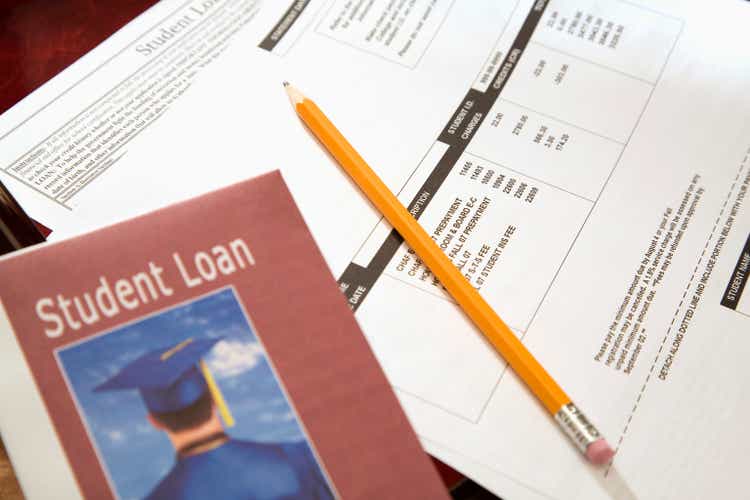
Jupiterimages/Stockbyte via Getty Images
For more than three years, repayments of federal student loans have been paused. With the Supreme Court ruling against President Biden’s student loan forgiveness, loan payments will restart in October, with interest beginning to accrue again in September.
That raises the question of how much consumer spending will fall as borrowers redirect what were discretionary dollars back to student loan payments. After an initial economic slump when COVID-19 it, the U.S. economy has been surprisingly resilient. How well can it weather withdrawal of a big pandemic-era fiscal support program?
In June, UBS said it expects the resumption of the payments to disproportionately reduce spending on apparel and pointed to a number of retailers likely to be affected. KeyBanc Capital Markets downgraded Target (TGT) on a similar thesis.
Student debt stood at ~$1.57T at the end of Q2, according to the Federal Reserve Bank of New York’s Quarterly Report on Household Debt and Credit. The U.S. Department of Education put the amount at $1.77T at the end of Q1. Both numbers are higher than the amount of credit card debt that U.S. consumers hold, which rose to $1.03T at June 30, 2023.
“With the resumption of loan interest in September and payments in October, investor fears have mounted that consumers will hit the brakes on spending, dragging down the economy,” said Ned Davis Research U.S. Chief Economist Veneta Dimitrova and Chief Global Strategist Joseph F. Kalish.
Rather, they don’t expect the restart to trigger a “watershed moment” for consumer spending or the U.S. economy. They estimate it will reduce Q4 GDP growth by 0.1%-0.2%, they wrote in a recent note.
Dimitrova and Kalish do see some downside risks for the economy due to an increase in the household debt service ratio, which indicates less discretionary income is available for spending. That risk is exacerbated by the low personal saving rate.
In Q2 2020, the consumer debt service ratio fell to 5.08% from 5.70% in the previous quarter. However, even with the payment pause, the ratio has increased to prepandemic levels, they said. With the resumption of loan payments, the debt service ratio can climb to near 6.30%, which would be the highest level since the mid-2000s and higher than the average of 5.67%.
The personal saving rate was 4.3% in June 2023, its lowest since 2008.
However, Dimitrova and Kalish also see some offsetting factors:
- Student loan borrowers skew toward higher-income households; that gives them the flexibility to “absorb loan payment resumption without a significant hit on discretionary spending.”
- They estimate that there is still almost $600B in excess savings from the pandemic, in aggregate. “Based on the rough estimate of$217 billion in annual student loan payments, this would be sufficient to cover payments for nearly 2.75 years,” they said.
- The federal government is also providing some income-driven repayment plans and it has created an “on-ramp” option to smooth the transition and guard against consequences of delinquency for up to a year.
So overall, the restart of student loans shouldn’t derail the U.S. economy or consumer spending, Kalish and Dimitrova wrote.
“It matters in the context of other household debt that has become more burdensome because of higher interest rates, but not enough to cause a recession on its own.”
Student loan-related stocks include: SoFi Technoogies (NASDAQ:SOFI), Navient (NASDAQ:NAVI), Nelnet (NYSE:NNI), and SLM Corp. (NASDAQ:SLM).
Dear readers: We recognize that politics often intersects with the financial news of the day, so we invite you to click here to join the separate political discussion.








